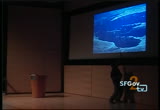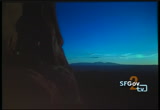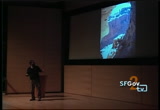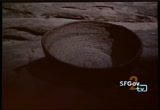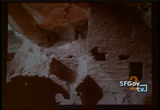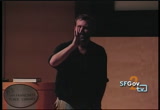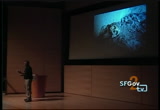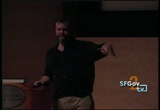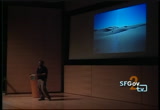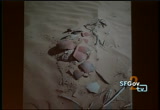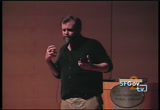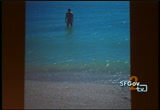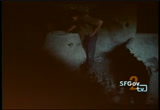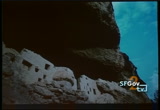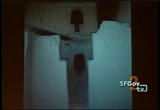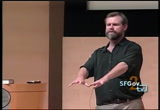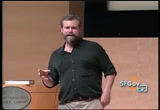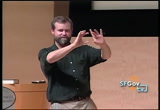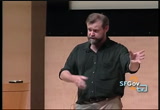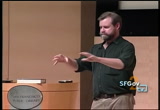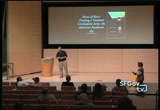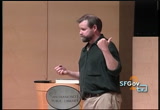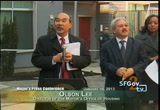tv [untitled] February 8, 2013 6:00am-6:30am PST
6:00 am
here and it drops down into another spot that you go through a saddle and around to the other side and through another saddle and down and around. it's this circuitous route that's constantly carrying you down deeper and deeper and this is the landscape is just covered with these. i don't take maps out there any more out into this place because it's all memory. this place is the map. i went down with my wife, reagan, and we went down a fairly large cliff face but one that had some good ledges on it so the only reason to have rope is to lower your pack. but we didn't get all the way down before sunset, so we set a camp out on the face. and it was the most spectacular camp i think i've ever had in my life. that's my spot. and it was just this narrow
6:01 am
ledge. i had a thermorest with me and it wasn't as wide as the thermorest so i had to put a rock under the thermorest for my head and reagan slept on top of me. nights are so solid, you don't move all night. just to get our stuff out to that ledge, you couldn't actually go with a pack. you had to take your pack off because there is a drop. you kind of have to jump from left to right. so you come up against the wall, you put your foot around and you do that. and then we unloaded our packs piece by piece and then handed each piece across so that then we could set our camp on the ledge and in the morning, we continued down the face lowering our packs until you
6:02 am
get down to the next level. and the next level falls out from itself. the ground constantly opening up. you can feel the wind and the water opening the earth as if there was no bottom to this, constantly finding the next route it take you from ledge to ledge to ledge, down through cracks and narrows, chimneys leading down step by step. until you get to this arch. it's a small arch, it's only about this tall. the photograph is a little -- well, size, scale dimension, they all kind of leave out there. right inside of this arch way there is a bunch of broken pottery so you know this was a used route a thousand years ago. and the arch leads down into a canyon that opens up and you go up a side canyon into this little alcove where a piece of
6:03 am
the ceiling has fallen just slightly. and i found this place. the first time i found this was on the 27th day of a back pack and i got up to this spot and i took my hat off and i stuck my head in the crack, which is something that i do frequently out there, because i know every once in a while you're going it see something back inside one of these cracks. and back in this crack there was a basket about 1500 years old that had been turned upside down so it wouldn't collect anything and it was way back down in the crack so that no light or wind would touch it. and it was in perfect condition. you could put it on your kitchen table. you could put apples in it. and as far as i know, it's still there except for that piece which we went on this trip to collect a piece for
6:04 am
radio carbon dating, a federal archeologist in southern utah had asked us to pick up one piece of it to bring out. so that part of the basket is missing. there are artifacts everywhere. they stand out. this arrowhead here is maybe just under half an inch long, tiny little piece made out of jasper in some canyon someplace. there are larger objects. there are cliff dwellings that you find up in the alcoves. this is out on the navajo reservation in southern utah. this is part of a structure that's about, i'd say, 300 rooms running along the back side of this canyon, a little
6:05 am
village, small city, something. artifacts everywhere. one of the walls had fallen out, revealing the floor that had been packed in there, hundreds of years of people using the same floor just pushing down the dirt so that there are pieces of woven -- of braided string sticking out of the floor everywhere and arrowheads and broken pottery and i realized when i came up against the stack of this trash pile i put my head against it and looked along it. i could see it was covered with hair. people in that room had been combing their hair for hundreds of years and it had been landing on the floor. and then new floors are built on top of that and new floors and i ran my hand across, just barely across, the front of this and i could feel the hair of people who had been there and i was there with a navajo guy that i know who just was creeped out by this.
6:06 am
because there's a certain heavy taboo in navaho culture about death and he said after we left this cliff dwelling, he said, i need a ceremony. too much death. you can't touch that much death, he said. but i'm from a different culture where we roll around in death, where we fill museums with death. this skull is from about a 5-year-old. and i found it because i thought it was a goerd. i saw the back side of it and it still had scalp on it and i thought, oh, a whole goerd. i reached down and picked it up and turned it around and had this face looking at me, which is a very odd thing. maybe i need a ceremony. these routes that i am following have led me all over
6:07 am
the place. the one i am about to tell you about didn't actually occur in house of rain. house of rain was getting too large, too many stories, but i was looking at how shells get traded. there are shell trade routes all over the southwest. shell was a primary material for making jewelry, for using in burials, and you had to walk 600 miles to get it, down to the sea of cortez, the water that's in between baja and the main land of mexico. and i tracked routes all the way down to the border over years and then across the mexican border into sonora and then it a place called penacate and then a dune, 5,000 square miles of sand dunes, a beautiful landscape, but no water out there. but pottery, broken pottery all over in certain places and
6:08 am
pieces of shell left behind where you could see that the people were crossing these dunes to the sea and picking up shell and then crossing back and then moving it up to phoenix and then from phoenix distributing it throughout the rest of the southwest. the first trip i took out there, we hit this mountain range right at the edge of the dunes. and we were carrying, i don't know, on that trip we were maybe carrying 80 or 90 pounds of water and moving it out to the sand and then we'd drop a cache and then go back and get more water and drop a cache. we were trying to get to the sea of cortez, that was one of the things on our mind, but this landscape, it starts turning your mind inward or outward or it gets hard to tell which way it turns it because it's a psychological place. there's no end to your horizons.
6:09 am
the sky is infinite, the sand is infinite. it's hard to keep your focus because you are constantly using peripheral vision looking all around you. it doesn't matter which way you walk after a while, you are just wandering. and so on the first trip out there, we didn't get to the sea because we just ended up wandering. it happens out there. you have a plan but the landscape becomes beautiful in a way that you weren't expecting and you start disappearing into it. you start forgetting why you are going in one direction. you start thinking, no, i just want to see that shadow over there and spend time there and then i want to see the next shadow and the next. it took 3 trips actually before we got to the sea. and all over at the edges of the dunes and sometimes even out in the middle of the dunes where you get into a deep hole, you will find a broken ceramic
6:10 am
ojalla, you will find a sea shell that somebody carried in there, you will pick up the shell going what were you doing out here, why were you walking in this place, were you seeing it the same way i'm seeing it? were you floating like a ghost or were you trudging and swimming and dragging yourself? what were you doing out here? on the last trip out, we did a lot of night walking. and we walked barefoot for the most part because it's much easier than walking in boots and it's just nice to walk barefoot for days and days at a time. on that trip in particular there were a lot of sidewinders out in the dunes which made for an interesting element because the previous trip there had been snakes but not so many. you would wake up in the morning and there would be
6:11 am
these elegant sidewinder tracks everywhere. the guy who dropped us off has the proclivity for picking up dangerous animals. i don't recommend it. it was kind of a terrifying experience to have somebody pick up a rattlesnake and go look at it, look at it, and put it right in your face and you are going, no, no, no thanks especially when he was the one driving around and leaving you out there to walk barefoot across the sand. out there where at times you are carrying 100 pounds of water, where you are carrying water in your hands, you are carrying water on your back, everything is about waterity there. you bury your water, you pick up your water, you strap it to your body. i remember on one of the trips carrying all this weight on my back and not sure why i had all this weight on my back. it was making me so clumsy, it was dragging me around and i started trying to unclip it and unbuckle all this stuff that i
6:12 am
was carrying out on the dunes so i could get rid of it finally until i realized, wow, you have really put a lot of buckles on this. you didn't want this stuff off you. it's water. don't drop your water. keep carrying it. drink it. this landscape is all about water. and on the last trip you can see the sea of cortez out there on the horizon. we walked to the edge of the dunes and even out there, just past the edge of the dunes, you would find places where there's -- there were piles of pottery, pottery scattered in the sand, and then the desert pan extended out and then you reach the sea of cortez that lies beyond. you know, i should -- i want to show you guys these next slides. i'm kind of running out of time here but i've got to show you
6:13 am
this place. i'm not going to go into heavy detail, i want to take you down here into the sierra madre. i was following routes all over for the house of rain, trying to figure out where the anastazi went when they left house of rain. many of them made the modern pueblos but other groups continued south. i followed pottery trails down into the sierra madre where my wife and two others went out and we came to these cliff dwellings. it seemed like every single cave we looked into had cliff dwellings. and this wasn't a place with trails. this wasn't a known location. many of these sites were pristine. they were just -- it looked as if people had just left suddenly, just like all the
6:14 am
stories in here. little cliff dwellings, little granaries, little sites falling apart. larger sites. this site went actually 5 layers deep into this cave. very particular to this region were these shaped storage rooms. this one is about 10 feet high. often they would have door stones sealing them on the top. and they were of all kinds of shapes and sizes, but they specific to that area. that's the smallest one we found. and then this is the largest one, about 15 feet tall. now, where these have fallen
6:15 am
over, they have broken open and you can see that they were just full of material. there's a woven mat right up there that's fallen out of that one. these sites were just covered with corn cobs where we'd go in and find a cache of corn cobs about 4 feet deep and 12 feet long, thousands and thousands of corn cobs and woven material all over the place, pieces of basketry, pieces of their sandals. this place is very well preserved. i mean a lot of this stuff is obviously worn, but it's been sitting there for 500 years. and what i found there that was very specific to anastazi were t-shaped doorways. you can see a large t-shape here. this is a very specific symbol
6:16 am
that you see in chaco canyon and you see in mesa verde. there are certain sites where they are finding t-shaped alters where pieces of stone about this size had been cut into t's and are standing up inside of rooms just covered with objects, with necklaces. so the shape obviously had some meaning. but it is a clear anastazi shape. it is a clear shape from the colorado plateau. we do see it in calinke, you see it in certain incan sites in south america. so it might be a pan american feature. i'm not sure what it is. some hopi people have told me that the t, the bottom of the t, goes down into a mythical underground lake so this is an upside down mountain that leads down into a place called the house of rain.
6:17 am
that is where twyla, probably oldest american deity, the rain deity, lives down in the house of rain and this is a t shape from up on the colorado plateau and that is the last picture on these slides, so -- the t shape, the pottery, i followed genetic information that you find in bones and teeth. i followed as many different pieces of information as i could and they sent me walking. i started in chaco canyon and walked north up to mesa verde, around to comb ridge in utah, down into the hopi mesa, across the mugion rim, to mexico and then into the sierra madre, following people, following routes. because everything in the desert leaves a route that
6:18 am
leads you somewhere. everything out there is a story. and that's what i'm following, these stories, looking for ways, looking for grains of sand out of place, looking for stories out in the middle of nowhere. i can open this up for questions if anybody has any questions. . >> i was wondering if they had any sort of metal or did they use hardened rocks of some sort to shape their stones? . >> most of what they did was stone. metallurgy was just starting to move up into northern chijuajua at that time and they were working with copper. that was just ornamental, so there was no metal going on at all other than imported bells. >> and the shells, they went
6:19 am
down to cortez -- not lake -- the cortez sea to get, was that mostly hard or brittle? . >> it was hard but not tool hard. the colorado plateau is covered with chert, a glassy rock that is really really good for making tools, making very sharp edges. you find there are pieces of chert all over the place and you can still cut your skin open very quickly with it and it's been sitting out in the open. >> where does chert come from? . >> it's a marine rock that's mostly silica. you find it in these layers, sandstone layers. if you are especially in a marine or water environment, you will find this layer of chert. it's in all colors, purple, green, red, blue.
6:20 am
it's a beautiful rock. . >> one thing i wanted to ask you, the review in the paper recently on sunday said that your book is different from all the other books about the anastazi because you brought out some of the non-flattering parts of their culture like violence. how did you conclude that they were a violent culture? . >> well, i didn't necessarily conclude they were a violent culture, i just concluded there was violence in their culture. the evidence is very clear where you find masker sites, where every place you drop a trench there are bodies, unburied bodies missing their heads, in some cases where there will be a head in one room and you can match it up to the body which is in another room 100 yards away and they didn't just end up there; somebody took the head off. and there will be places where
6:21 am
it's all femurs, all gathered together. and places where it's obviously some kind of warfare event where people are all huddled into one spot and they have all been burned there. the record is very clear of some intense violence and it comes up at a very certain point in time. it comes up in the 10th century right before large migrations you see this layer of violence. and it doesn't cover everything. sometimes a series of pueblos will all be destroyed over here and then a series of pueblos over here are in perfect condition as far as the walls aren't broken down, there aren't bodies all over the place. it looks like the place was left very peacefully or ceremoniously where you can see they left artifacts out.
6:22 am
different people had different ends but you can see where different people had unfortunate ends. i don't want to get into the details, it's in the book, but fairly grisly evidence. there are pockets of violence. these were human beings. some of the anastazi were beautiful, wise, balanced with the earth people and it's like, no, they were us, doing their neolithic stone age thing but still us, human beings living in a place, chopping each other into little pieces sometimes and living lives of prosperity at other times. >> we have time for one more question.
6:23 am
>> was the global warming when they were (inaudible) greenland and a cathedral there and i believe the maya moved from the lowlands to the highlands and the anastazi came down to the salt river. >> yeah, a lot of the movement was based on climate. the anastazi were always moving. the whole thing about the disappearing anastazi, you go to where they are living and they disappear all of a sudden. but you follow them and find, oh, 10 years later they are over here and 70 years later they are over here. they are often being driven by these climate changes which on the colorado plateau, very small changes make you go. if you lose one inch of precipitation in one year, you got to get up to the mesas where there's a little more rain and then when the frost comes in too early, you got to get down to the desert. around 1276 or so the water was running out, the seasons were
6:24 am
no good, and i think they just looked at their trade routes and said let's follow these and go south. they were always getting pushed around by the environment. . >> okay, thank you, craig, so much. thank you for coming. craig is happy to take some more informal questions in back and of course his book, house of rain, is available for sale in back too. thank you so much and thank you, craig childs. * * * * * * * * * * * * * * * * * * * * * * * * * * * * * * * *
6:25 am
>> okay, we're just about ready to get started here. if everybody could gather round a little bit. my name is olson lee. i'm the director of the mayor's office of housing. and this is a great day, isn't it? >> yes, it is. >> it's a great day. and one of the things about anything that we do in san francisco is that it does take a whole village, and we have a whole village here. and it's about a sense of partnership that we are able to celebrate. and i really want to emphasize celebration, because this is the first phase of the first phase of many projects like this in san francisco. (applause) >> and this is something that is an only in san francisco development where we're rebuilding distressed public housing for the current residents, and doing this in a
6:26 am
way that is -- contributes to the neighborhoods. it contributes to the health and welfare of the existing families and invites new families and creates complete neighborhoods. and only in san francisco are we willing to take on this task to really change the lives of the current residents and preserve affordable housing for all future residents so that we in san francisco have a diverse community. so, we have a very short program today to acknowledge many of the people who have participated in this development. it has been a partnership, as we have talked about. it is a partnership of many city departments. it's been a partnership of many nonprofits and a partnership of many individuals. and it's been a partnership with the residents. and, so, i would like to start
6:27 am
the program by introducing mayor lee, who is responsible for, among many things, the housing e trust fund which will ensure the work we start here today will continue into the future. mayor lee. (applause) >> thank you. thank you, olson. and thank you for your leadership and work on this as well. everybody, thank you for coming out today. i know it's cold, but it feels really, really warm. and as carlos and miguel just showed me -- ask these are of course the two youngest of the five kids that alice gutierrez has. thank you very much. [cheering and applauding] >> alice, you and the family know better than i do that the bunkers that were built in the '50s that represented hunters view for many, many years were actually built for the military housing back in those years. they weren't really meant for long-term dignified respectful housing that this community deserves. and, so, you are part of the
6:28 am
first of 25 families that are in this initial phase of a whole 107 units that will be completed in may. and thanks to all of our partners as olson continues to repay. i just want to emphasize this is the first phase. supervisor malia cohen and i are going to be working hard with many of you here today for a long time. this is something we've dreamed of and i know you dreamed of it just in terms of being able to live in san francisco, afford it here. your kids are so happy to see their rooms and all their giants posters and the views of the bay. but we also want to assure you that we're just beginning to complete a really long-held promise, malia, that you and i and other supervisors have made. and we signalled that back when gavin was mayor. he made the bold announcement back in 2006, with the board of
6:29 am
supervisors as a whole, that knowing that it was over $267 million of unmet infrastructure needs in the whole public housing complex, and that on an annual basis, the hud and the federal government were only able to come up with 16 million, and decreasing every year based upon their inability to get together on hud priorities, that we created hope sf. and out of that came a $95 million commitment. i'm going to see to it that not only every penny of that comes in, but there will be more coming from the private sector because hope sf is about the public-private partnership that we have, that we should never allow our public housing residents to live in isolation from whole communities that i enjoy, that all of you enjoy so much. because when we live in our communities, guess what? we have a neighborhood business district. we have job training. we get child care. we get
45 Views
IN COLLECTIONS
SFGTV2: San Francisco Government Television Television Archive
Television Archive  Television Archive News Search Service
Television Archive News Search Service 
Uploaded by TV Archive on

 Live Music Archive
Live Music Archive Librivox Free Audio
Librivox Free Audio Metropolitan Museum
Metropolitan Museum Cleveland Museum of Art
Cleveland Museum of Art Internet Arcade
Internet Arcade Console Living Room
Console Living Room Books to Borrow
Books to Borrow Open Library
Open Library TV News
TV News Understanding 9/11
Understanding 9/11